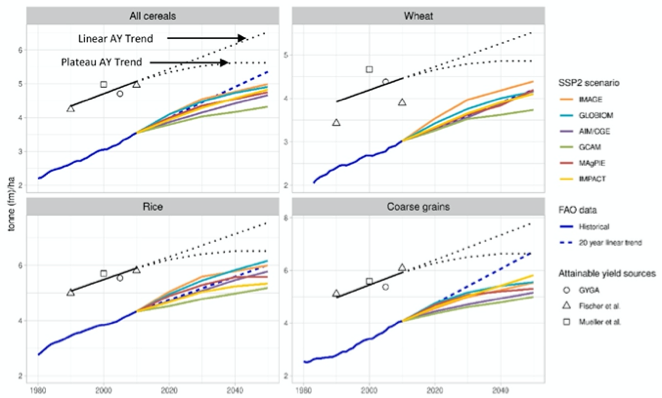AgMIP Global Economics
Coordination Team
Hermann Lotze-Campen
Potsdam Institute for Climate Impact Research (PIK), Germany
Dominique van der Mensbrugghe
Center for Global Trade Analysis, Purdue University, USA
Hans van Meijl
Wageningen University and Research (WUR), the Netherlands
Ignacio Perez-Dominguez
The Institute for Prospective Technological Studies/Joint Research Centre (JRC), Spain
Keith Wiebe
International Food Policy Research Institute (IFPRI), USA
Elke Stehfest
Netherlands Environmental Assessment Agency (PBL), the Netherlands
Shinichiro Fujimori
Kyoto University, Japan
Petr Havlík
International Institute for Applied System Analysis (IIASA), Austria

Recent result: Global average crop yields as projected until 2050 by AgMIP global economic models stay below observed attainable yields. Source: van Zeist et al., GEC 2020: https://doi.org/10.1016/j.gloenvcha.2020.102120
Background
Since 2012 the global economics (GlobEcon) team in AgMIP has conducted several systematic model intercomparisons, published joint papers and actively contributed to recent IPCC reports. Currently, 10 global economic modelling teams are actively involved in these activities (see list below). Main topics are comparing future socio-economic baseline projections (based on the Shared Socio-economic Pathways, SSP), climate impacts on the agriculture and food sector, effects of ambitious climate change mitigation, and projections of dietary change and land use change. The GlobEcon team is cooperating closely with other AgMIP teams, e.g. the Global Gridded Crop Model Intercomparison (GGCMI) team and the Regional Integrated Assessment (RIA) team.
Scenario databases
Selected data sets linked to the GlobEcon papers are accessible at the JRC DataM portal: https://datam.jrc.ec.europa.eu/datam/area/CLIMATE_CHANGE
Publications from the GlobEcon team
van Zeist et al. (2020): Are scenario projections overly optimistic about future yield progress? Global Env. Change 64 (102120). https://doi.org/10.1016/j.gloenvcha.2020.102120
Stehfest, E. et al. (2019): Key determinants of global land-use futures. Nature Communications 10 (2166). https://www.nature.com/articles/s41467-019-09945-w
Frank et al. (2018): Agricultural non-CO2 emission reduction potential in the context of the 1.5 °C target. Nature Climate Change 9: 66–72.
https://doi.org/10.1038/s41558-018-0358-8
Hasegawa, T. et al. (2018): Risk of increased food insecurity under stringent global climate change mitigation policy. Nature Climate Change 8: 699-703. https://www.nature.com/articles/s41558-018-0230-x
van Meijl, H. et al. (2018): Comparing impacts of climate change and mitigation on global agriculture by 2050. Environ. Res. Lett. 13 (064021). https://iopscience.iop.org/article/10.1088/1748-9326/aabdc4
Wiebe, K. et al. (2015), “Climate change impacts on agriculture in 2050 under a range of plausible socioeconomic and emissions scenarios”, Environ. Res. Lett. 10(2015) 085010, http://iopscience.iop.org/1748-9326/10/8/085010
Nelson, G. C. et al. (2014): Climate change effects on agriculture: Economic responses to biophysical shocks. PNAS, 111, 9, 3274-3279. http://dx.doi.org/10.1073/pnas.1222465110;
Open access: http://www.ncbi.nlm.nih.gov/pmc/articles/PMC3948295/?report=classic
Special Issue, Agricultural Economics, 45(1), 2014:
Nelson, G.C. and Shively, G.E. (2014): Modeling climate change and agriculture: an introduction to the special issue. Agricultural Economics, 45(1).
http://onlinelibrary.wiley.com/doi/10.1111/agec.12093/abstract
von Lampe, M. et al. (2014): Why do global long-term scenarios for agriculture differ? An overview of the AgMIP Global Economic Model Intercomparison. Agricultural Economics, 45(1). http://onlinelibrary.wiley.com/doi/10.1111/agec.12086/abstract
Nelson, G.C. et al. (2014): Agriculture and climate change in global scenarios: why don’t the models agree? Agricultural Economics, 45(1).
http://onlinelibrary.wiley.com/doi/10.1111/agec.12091/abstract
Müller, C. and Robertson, R. (2014): Projecting future crop productivity for global economic modeling. Agricultural Economics, 45(1).
http://onlinelibrary.wiley.com/doi/10.1111/agec.12088/abstract
Robinson, S. et al. (2014): Comparing supply-side specifications in models of global agriculture and the food system. Agricultural Economics, 45(1).
http://onlinelibrary.wiley.com/doi/10.1111/agec.12087/abstract
Valin, H. et al. (2014): The future of food demand: understanding differences in global economic models. Agricultural Economics, 45(1).
http://onlinelibrary.wiley.com/doi/10.1111/agec.12089/abstract
Schmitz, C. et al. (2014): Land-use change trajectories up to 2050: insights from a global agro-economic model comparison Agricultural Economics, 45(1).
http://onlinelibrary.wiley.com/doi/10.1111/agec.12090/abstract
Lotze-Campen, H. et al. (2014): Impacts of increased bioenergy demand on global food markets: an AgMIP economic model intercomparison. Agricultural Economics, 45(1).
http://onlinelibrary.wiley.com/doi/10.1111/agec.12092/abstract
Modelling teams
Partial equilibrium (PE) models
- CAPRI (JRC, Perez-Dominguez et al.)
- GCAM (PNNL, Kyle et al.)
- GLOBIOM (IIASA, Havlík, Valin et al.)
- IMPACT (IFPRI, Wiebe, Sulser et al.)
- MAgPIE (PIK, Lotze-Campen, Popp, et al.)
General equilibrium (CGE) models
- AIM (NIES, Fujimori, Hasegawa et al.)
- ENVISAGE (Purdue/GTAP, van der Mensbrugghe et al.)
- FARM (USDA, Sands)
- MAGNET (WUR, van Meijl et al.)
Integrated assessment models (IAM)
- IMAGE (PBL, Stehfest et al.)
